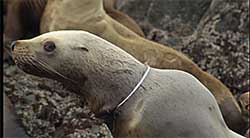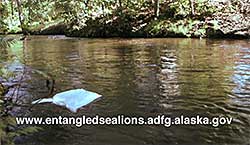Alaska Fish & Wildlife News
September 2013
Moving Pictures
Addressing Killer Trash in the Ocean

“Iron Eyes” Cody crying by the road remains a powerful image. The Keep America Beautiful campaign wanted to make people care about litter, and like a lot of kids in the early 1970s, Sue Goodglick was moved by the “crying Indian” public service television commercial.
All litter is ugly, but some is also deadly. Now a marine mammal biologist with the Alaska Department of Fish and Game, Goodglick is working to address killer trash in the oceans. She and her federal colleagues with the National Oceanic and Atmospheric Administration are particularly concerned about loops and bands entangling sea lions. They’ve formed a group with other concerned parties, the Pinniped Entanglement Group (PEG), and meet via teleconference every few months to come up with ways to reduce the number of entangled marine mammal through education and outreach.
Remembering the effectiveness of the Keep America Beautiful commercial, Goodglick suggested a 30-second video PSA that could be broadcast on television across Alaska. The group supported the idea, and worked with producer Tom Pillifant to craft a PSA.

“I believe that Keep America Beautiful PSA with Chief Iron Eyes Cody, who sheds a tear at the sight of all the litter in our world back in the '70’s inspired me at 4-years-old to become a better steward of the planet,” she said.
The entanglement PSA does not feature a professional actor playing an iconic Native American, but it does show the out-of-sight, out-of-mind consequences of marine debris.
Goodglick said the members of the pinniped group hope that seeing images of entangled animals in the PSA might inspire others to be better stewards of Alaska’s waterways – and beyond.
From 2000 – 2012, biologists documented at least 250 Steller sea lions in Southeast Alaska with some sort of entangling debris around their head or neck. Sea lions, especially young animals, investigate and play with objects they find. An animal that plays with or swims through a loop can find itself with an unwanted noose around its neck that can strangle it as it grows or gets caught on something else. Loops in rope, fishing line, nets, packing bands, and rubber inner tube material used to secure crab pots can be deadly.

Synthetic materials are the worst, because they are tough and persistent; plastic monofilament fishing line can last more than 600 years - that’s a long time to cause a lot of problems in the environment. In the last 50 years plastics and other synthetics have replaced natural fibers in many products, including those used in the packaging and shipping industries. More than 300 million metric tons of plastics are produced worldwide each year. Roughly 50 percent of this volume is made up of products that are thrown away within one year of purchase.
Watch the PSA and learn more about the entanglement issue.
Subscribe to be notified about new issues
Receive a monthly notice about new issues and articles.
